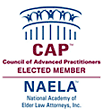
During his relationship with life partner Marc Coleman, the decedent executed a Last Will and Testament naming Coleman as the executor and primary beneficiary of his estate. The couple later ended their relationship. Thereafter, the decedent entered into a new relationship with Kirston Baylock. The decedent later died unexpectedly.
At issue was a hand-written codicil the decedent wrote during his relationship with Baylock, in which he named Baylock as the executor and primary beneficiary of his estate. The codicil was written using the decedent’s own blood as ink.
After Baylock sought to admit the will and codicil to probate, Coleman filed an answer contesting the validity of the codicil.
The parties engaged in discovery and a trial, during which both sides presented testimony from handwriting and DNA experts. The experts agreed that the blood used to pen the codicil was the decedent’s, and that the handwriting of the body of the codicil was the decedent’s. However, Coleman’s expert could not rule out the possibility that the signature was not genuine.
At the close of Coleman’s experts’ testimony, the estate moved for a directed verdict. Coleman opposed the motion, arguing that he had additional witnesses who would testify that the signature was not on the codicil at the time of the decedent’s death, and must have been added thereafter. The estate also sought frivolous litigation sanctions.
The trial court denied the frivolous sanctions motion, but granted a directed verdict to the estate. With regard to the codicil, the judge concluded that there was clear and convincing evidence that the decedent intended the document to serve as an amendment to his will, even assuming that there had not been a signature. As to the frivolous litigation motion, the judge concluded that Coleman had taken reasonable positions in the litigation in light of the “eccentric” nature of the decedent’s blood-inked codicil.
On appeal, both rulings were affirmed.
With regard to the codicil, the Appellate Division found that the validity of the document was governed by N.J.S.A. 3B:3-3, which addresses documents that were not executed in compliance with the technical requirements for a traditional or holographic will. Pursuant to N.J.S.A. 3B:3-3, such a document is valid if the proponent of the document establishes by clear and convincing evidence that the decedent intended it to be his will/codicil. Notably, case law has established that, to be recognized as such, the document need not be signed by the testator.
There was clear and convincing evidence that the body of the document was written by the decedent, and his testamentary intent was established through the words of the document itself. The decedent referred to the document as his “codicil,” set forth that it was being freely attested to, and repeatedly referenced the ways in which the document was to amend the will. Consequently, even if Coleman could prove that the decedent never actually signed the document, the codicil was valid, because a signature is not a requirement under the law.
A copy of In the Matter the Estate of Bradway can be found here – In the Matter of the Will of E. Warren Bradway, Deceased
For additional information concerning estate planning and administration, visit:
For additional information concerning New Jersey elder law, visit:
Categories
- Affordable Care Act
- Alzheimer's Disease
- Arbitration
- Attorney Ethics
- Attorneys Fees
- Beneficiary Designations
- Blog Roundup and Highlights
- Blogs and Blogging
- Care Facilities
- Caregivers
- Cemetery
- Collaborative Family Law
- Conservatorships
- Consumer Fraud
- Contempt
- Contracts
- Defamation
- Developmental Disabilities
- Discovery
- Discrimination Laws
- Doctrine of Probable Intent
- Domestic Violence
- Elder Abuse
- Elder Law
- Elective Share
- End-of-Life Decisions
- Estate Administration
- Estate Litigation
- Estate Planning
- Events
- Family Law
- Fiduciary
- Financial Exploitation of the Elderly
- Funeral
- Future of the Legal Profession
- Geriatric Care Managers
- Governmental or Public Benefit Programs
- Guardianship
- Health Issues
- Housing for the Elderly and Disabled
- In Remembrance
- Insolvent Estates
- Institutional Liens
- Insurance
- Interesting New Cases
- Intestacy
- Law Firm News
- Law Firm Videos
- Law Practice Management / Development
- Lawyers and Lawyering
- Legal Capacity or Competancy
- Legal Malpractice
- Legal Rights of the Disabled
- Liens
- Litigation
- Mediation
- Medicaid Appeals
- Medicaid Applications
- Medicaid Planning
- Annuities
- Care Contracts
- Divorce
- Estate Recovery
- Family Part Non-Dissolution Support Orders
- Gifts
- Life Estates
- Loan repayments
- MMMNA
- Promissory Notes
- Qualified Income Trusts
- Spousal Refusal
- Transfers For Reasons Other Than To Qualify For Medicaid
- Transfers to "Caregiver" Child(ren)
- Transfers to Disabled Adult Children
- Trusts
- Undue Hardship Provision
- Multiple-Party Deposit Account Act
- New Cases
- New Laws
- News Briefs
- Newsletters
- Non-Probate Assets
- Nursing Facility Litigation
- Personal Achievements and Awards
- Personal Injury Lawsuits
- Probate
- Punitive Damages
- Reconsideration
- Retirement Benefits
- Reverse Mortgages
- Section 8 Housing
- Settlement of Litigation
- Social Media
- Special Education
- Special Needs Planning
- Surrogate Decision-Making
- Taxation
- Technology
- Texting
- Top Ten
- Trials
- Trustees
- Uncategorized
- Veterans Benefits
- Web Sites and the Internet
- Webinar
- Writing Intended To Be A Will







Vanarelli & Li, LLC on Social Media